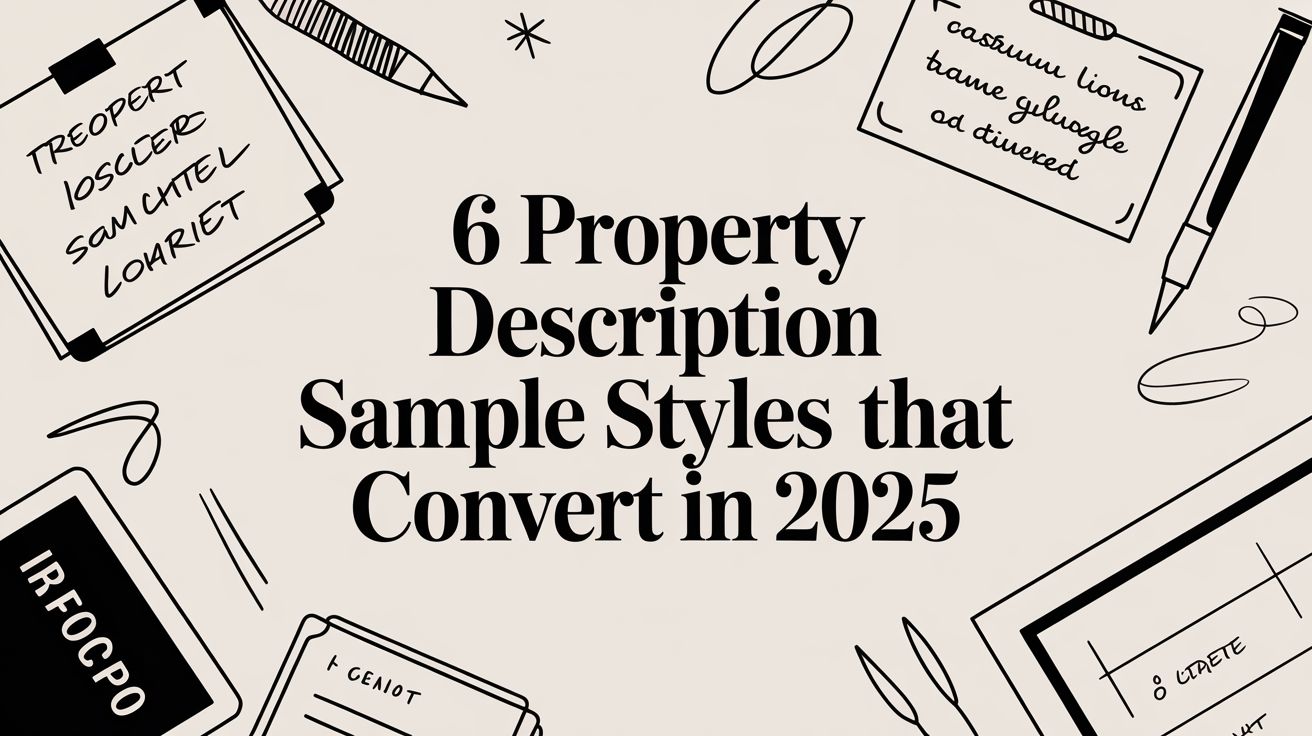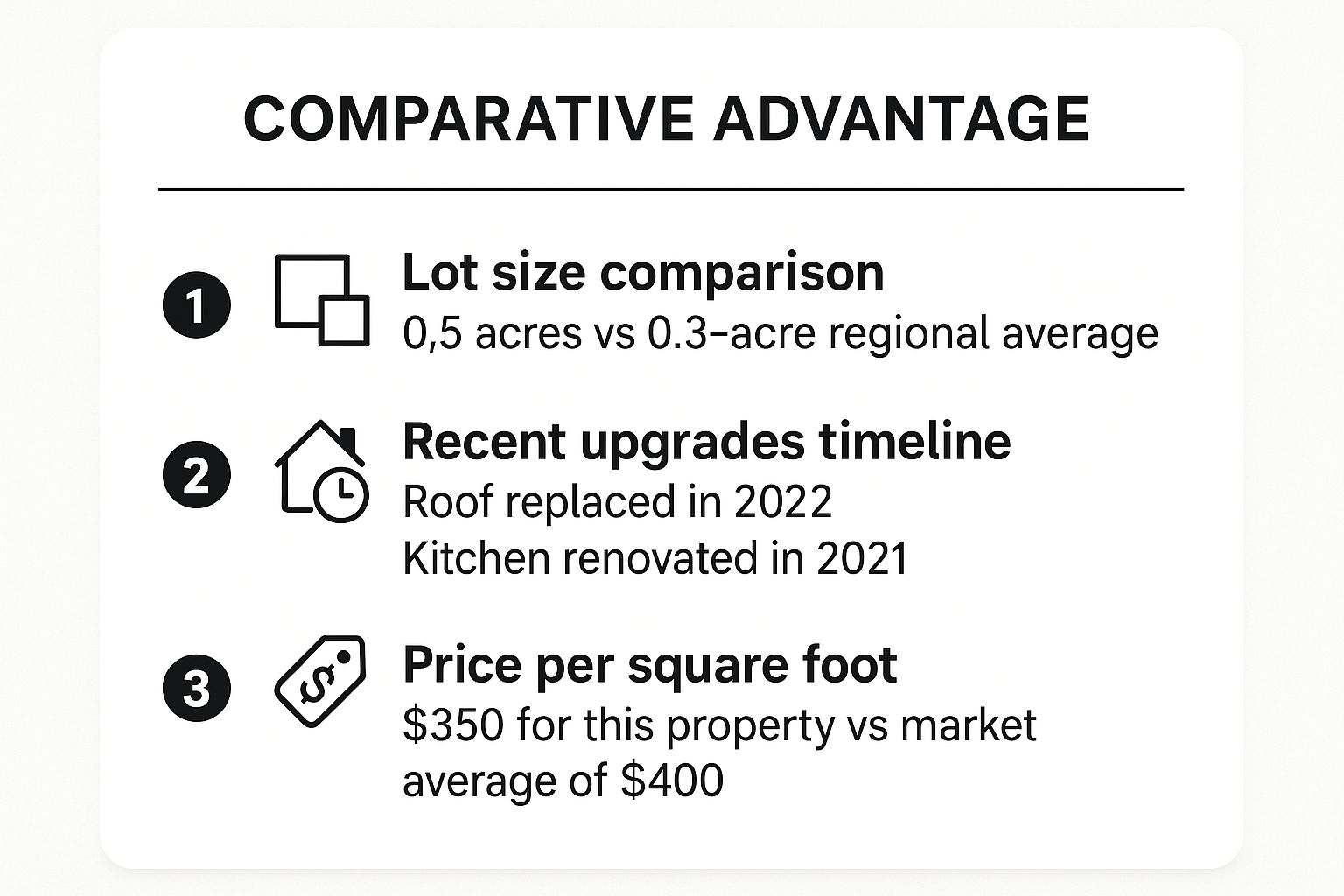6 Property Description Sample Styles That Convert in 2025

In a competitive market, a generic property description fails to capture attention, blending into a sea of listings that all sound the same. The difference between a property that sits and one that sells often comes down to the words you choose. This guide moves beyond basic adjectives like "charming" or "cozy" to explore six distinct, strategic approaches to writing compelling property descriptions that resonate with specific buyer profiles.
We will provide a detailed property description sample for each strategy, followed by a tactical deconstruction. You won't just see an example; you'll learn the underlying psychology and the specific techniques that make it effective. Our analysis will break down why each style works, who it targets, and how you can replicate its success.
This article is designed to be a practical toolkit. You will leave with a replicable framework for every type of listing, from a modern downtown condo to a sprawling suburban family home. By mastering these methods, you can transform your listings from simple information dumps into powerful sales tools that attract qualified leads, create emotional connections, and ultimately, close deals more effectively. Let's begin.
1. The Storytelling Approach Property Description
The Storytelling Approach transforms a property listing from a simple inventory of features into an emotional narrative. Instead of just stating facts like "3 bedrooms, 2 baths," this method paints a vivid picture of the lifestyle the home offers. It uses sensory language and emotional triggers to help potential buyers imagine themselves living in the space, creating a powerful personal connection before they even step inside.

This property description sample works by tapping into the buyer's aspirations. It describes moments and experiences, such as sipping coffee on a sun-drenched patio or hosting lively dinner parties in an open-concept kitchen. The goal is to sell the feeling of the home, making it memorable in a crowded market.
Strategic Breakdown
This technique is especially effective for unique, historic, or luxury properties where the character and ambiance are major selling points. High-end firms like Sotheby’s International Realty master this by weaving a tale around a property's history, architecture, or stunning location.
Key Tactic: Focus on the "why" behind a feature. Don't just mention the "chef's kitchen"; describe the joy of "crafting gourmet meals on the expansive quartz countertops while guests mingle around the oversized island." This frames the feature within a desirable lifestyle experience.
Actionable Takeaways
To implement this strategy, focus on creating a sensory journey for the reader.
- Start with a Hook: Begin with the most captivating aspect of the home. Is it the breathtaking sunset view from the balcony or the cozy fireplace in the living room? Lead with that moment.
- Use Sensory Language: Incorporate words that appeal to sight, sound, smell, and touch. Describe the "warmth of the hardwood floors," the "gentle breeze flowing through the open windows," or the "scent of blooming jasmine in the garden."
- Balance Emotion and Fact: While storytelling is key, you must ground it in reality. Seamlessly weave in essential details like square footage, recent upgrades, and room dimensions. For example, "Imagine hosting summer barbecues in the sprawling, fully-fenced backyard (over a quarter-acre), complete with a new composite deck installed in 2023."
- End with an Evocative CTA: Conclude by reinforcing the lifestyle dream. Instead of "Schedule a showing," try "Your story begins here. Contact us today to experience this exceptional home for yourself."
2. The Feature-Focused Bulleted List Description
The Feature-Focused Bulleted List approach prioritizes clarity and efficiency, presenting a property's attributes in a scannable format. Instead of weaving details into a narrative, this method organizes key information into concise bullet points, allowing potential buyers to quickly verify if the home meets their specific criteria like room count, square footage, and recent upgrades. It’s the go-to format for data-driven buyers who want facts first.

This property description sample works by delivering information with maximum impact and minimal fluff. For buyers comparing multiple listings on portals like Zillow or Redfin, this format makes it easy to cross-reference features and make quick, informed decisions. The goal is to present a comprehensive, transparent overview that builds trust and answers key questions upfront.
Strategic Breakdown
This technique is a staple for Multiple Listing Service (MLS) systems and is highly effective for new construction developments, condos with standard layouts, or any property where practical features are the primary draw. It appeals to analytical buyers who value specifications over sentiment and want to ensure the property checks all their non-negotiable boxes before scheduling a tour.
Key Tactic: Lead with a powerful, one-sentence summary to provide context before diving into the bullets. For example, "Meticulously maintained and thoughtfully updated, this 4-bedroom colonial offers modern amenities and classic charm in the heart of the desirable Northwood neighborhood." This intro frames the detailed list that follows.
Actionable Takeaways
To implement this strategy effectively, focus on organization and precision.
- Prioritize and Group: Start the list with the most compelling features, such as "Brand-New Chef's Kitchen (2023)" or "Primary Suite with Spa-Like Bath." Group related items under subheadings like "Interior Highlights," "Exterior & Lot," and "Recent Upgrades" for easy navigation.
- Be Specific and Quantify: Vague points are less impactful. Instead of "new roof," use "New Architectural Shingle Roof (Installed 2022, 30-year warranty)." Include dimensions for key rooms and lot size to provide concrete data.
- Use Action-Oriented Language: Even in a list, you can use engaging language. Phrases like "Gleaming hardwood floors throughout," "Energy-efficient stainless steel appliances," or "Private, fully-fenced backyard perfect for pets" add a touch of appeal without sacrificing clarity.
- Conclude with a Clear CTA: After providing all the essential data, end with a direct and simple call to action. A straightforward "Contact us to schedule your private showing today!" is a perfect, no-nonsense conclusion to this fact-based format.
3. The SEO-Optimized Property Description
The SEO-Optimized approach fuses compelling sales copy with search engine optimization principles to achieve maximum online visibility. It strategically embeds keywords potential buyers are using in search engines like Google, such as neighborhood names, school districts, architectural styles, and specific amenities, directly into the listing text. The result is a property description sample that is both persuasive to humans and highly visible to search algorithms.
This method ensures a property appears in the most relevant online searches, driving organic traffic directly to the listing. By anticipating what buyers are typing into the search bar, this property description sample captures high-intent leads before they even land on major portals like Zillow or Redfin, giving the listing a significant competitive advantage.
Strategic Breakdown
This technique is essential for any agent or brokerage operating in a competitive digital market. Platforms like Zillow and real estate marketing agencies have perfected this by understanding local search trends and buyer behavior. The strategy is to answer a buyer's unasked questions through keywords embedded in a natural, flowing narrative. To effectively optimize your property descriptions, explore specialized real estate SEO strategies to rank higher locally.
Key Tactic: Think like a buyer. Instead of just "large backyard," use a long-tail keyword like "spacious, fenced backyard perfect for pets in the Northwood school district." This single phrase targets location, features, and specific buyer needs, drastically improving search relevance.
Actionable Takeaways
To effectively implement this strategy, blend data-driven keyword research with engaging copy.
- Identify Local Keywords: Use free tools like Google Trends or paid platforms to find what buyers in your area are searching for. Include the full address, neighborhood name ("a stunning Tudor in the historic Elmwood Park"), and nearby landmarks.
- Integrate Keywords Naturally: Avoid "keyword stuffing." Weave your target phrases into the description logically. For instance, "This updated 3-bedroom ranch offers true one-level living..." is much better than "Ranch home, 3 bedroom, one level living."
- Optimize Titles and Headers: Your listing title is critical. Keep it under 60 characters for optimal display in search results and lead with the most compelling, keyword-rich information, such as "Charming Brick Home in Downtown Greenville."
- Include a Geo-Focused CTA: End with a call to action that reinforces the location. Instead of "Call for a tour," try "Come see what makes the Oakhurst neighborhood so desirable. Schedule your private tour today!"
4. The Problem-Solution Property Description
The Problem-Solution Approach is a persuasive copywriting technique that positions a property as the direct answer to a buyer's common frustrations. Instead of simply listing features, this method identifies a specific pain point in the market, such as a lack of home office space or a grueling commute, and then explicitly demonstrates how the property solves it. This creates an immediate sense of relevance and value, making the buyer feel understood.

This property description sample works by showing empathy for the buyer's journey. It acknowledges the challenges of their search, whether it's finding a home in a top-rated school district or securing enough storage for a growing family. By framing the property’s features as targeted solutions, the listing feels less like a sales pitch and more like a helpful discovery.
Strategic Breakdown
This technique is highly effective for properties that serve a clear demographic or solve a common local issue. Real estate teams focused on conversion optimization use this method to resonate with specific buyer profiles, such as remote workers, commuters, or hobbyists needing extra space.
Key Tactic: Identify the target buyer's biggest frustration and lead with the solution. Instead of saying, "has a finished basement," you would say, "Tired of searching for a home with enough space for work and play? The fully finished lower level offers a private home office plus a separate media room, solving your space dilemma."
Actionable Takeaways
To implement this strategy, you must first understand your target audience's pain points.
- Start with the Problem: Open your description by acknowledging a common struggle. For an urban condo, you might start with, "End your stressful commute. This home is just a 5-minute walk from the main transit station."
- Present Features as Solutions: Frame each relevant feature as a direct benefit that alleviates a problem. A large garage isn't just a garage; it's the "solution to your storage woes and the perfect workshop for your hobbies."
- Use Data to Prove the Solution: Whenever possible, back up your claims. Mentioning the home is "located in the district's #1-rated elementary school" provides a concrete solution for families concerned about education.
- Maintain a Positive Frame: While you're highlighting a problem, the overall tone should be positive and empowering. The focus is on the relief and satisfaction the home provides, not the frustration itself. Your call to action could be, "Stop compromising. Find the space you need right here."
5. The Comparative Advantage Property Description
The Comparative Advantage approach strategically positions a property as superior to its competition without directly criticizing other listings. It highlights unique, verifiable features, recent upgrades, or location benefits that differentiate it from similar properties on the market. This method helps buyers quickly recognize superior value, making it a powerful tool in high-inventory or competitive areas.

This property description sample works by presenting undeniable facts that underscore the home's value proposition. Instead of just saying a home is "a great deal," it provides the data to prove it, such as recent, costly upgrades or a larger lot size than the neighborhood average. The goal is to guide the buyer's decision-making process with clear, logical evidence.
Strategic Breakdown
This technique is especially effective for newly renovated homes, properties with unique lots, or listings with significant energy-efficient upgrades. Competitive market specialists and luxury real estate teams use this method to justify a price point and create a sense of urgency by showcasing features that are rare or impossible to find elsewhere in the same price bracket.
Key Tactic: Quantify the advantage. Don't just mention a "new roof"; state that the "architectural shingle roof was fully replaced in 2022 (a $15,000 value), offering peace of mind for years to come." This anchors the feature's value in a tangible, compelling figure that competing listings may lack.
Actionable Takeaways
To implement this strategy, build your description around factual points of superiority.
- Lead with the Strongest Differentiator: Start with the most compelling advantage. Is it the brand-new HVAC system, the oversized corner lot, or the significantly lower cost per square foot compared to area comps? Make this the headline of your description.
- Use Specific Dates and Numbers: Vague claims are weak. Use specifics like, "Gourmet kitchen fully renovated in 2021 with quartz countertops," or "Enjoy energy savings with new double-pane windows installed in 2023." This builds credibility and trust.
- Highlight Cost Savings and Future Value: Frame upgrades as a direct financial benefit. Mentioning energy-efficient appliances or a new water heater translates into lower utility bills, which is a powerful motivator for buyers comparing long-term ownership costs.
- Maintain a Professional Tone: The goal is to elevate your property, not tear down others. Avoid negative language about competing listings. Let the facts speak for themselves, presenting your listing as the clear, logical choice.
6. The Technical Specification Property Description
The Technical Specification Approach is a data-driven method that prioritizes comprehensive, factual information over emotional narratives. Instead of describing a lifestyle, this format presents a detailed inventory of the property’s components, from construction materials and system specifications to energy ratings and compliance certifications. It caters to a specific buyer who values precision, transparency, and objective data for their decision-making process.

This property description sample works by building trust and demonstrating expertise. It provides sophisticated buyers, investors, or engineers with all the information they need to conduct due diligence, often without a physical visit. The goal is to eliminate uncertainty and present the property as a well-documented, quantifiable asset.
Strategic Breakdown
This technique is essential for commercial real estate, new construction homes, high-performance "smart" homes, and investment properties. Marketers for institutional investment firms and commercial brokerages like CBRE or JLL rely on this format to communicate value to a professional audience who scrutinizes every detail from HVAC capacity to zoning regulations.
Key Tactic: Structure the data for scannability. Don't present a wall of text; use clear categories and subheadings like "Mechanical Systems," "Exterior Finishes," or "Energy Efficiency." This allows buyers to quickly find the specific information they care about, such as the age of the roof or the brand of the HVAC system.
Actionable Takeaways
To implement this strategy effectively, focus on accuracy, organization, and comprehensive detail.
- Categorize Information: Group details logically. Create sections for structural elements, plumbing, electrical, interior finishes, and major appliances. For example, under "HVAC," list the brand, model, installation date (2022), and last service date.
- Be Hyper-Specific: Vague descriptions won't work here. Instead of "new windows," specify "Andersen 400 Series double-hung windows with Low-E4 glass, installed in 2023, with a transferable warranty." Mentioning brands like Sub-Zero, Bosch, or Trane adds perceived value.
- Include Documentation: Reference or provide links to official documents. Mentioning that floor plans, site plans, and recent energy audit results are available upon request adds significant credibility. This shows you have done your homework and are transparent.
- End with a Professional CTA: Your call to action should match the tone. Instead of a creative hook, opt for a direct approach like, "A full specification sheet and due diligence package are available for qualified buyers. Contact us to request access and schedule a technical walkthrough."
6 Approaches to Property Description Comparison
| Description Style | Implementation Complexity 🔄 | Resource Requirements 🔄 | Expected Outcomes 📊 | Ideal Use Cases 💡 | Key Advantages ⭐ |
|---|---|---|---|---|---|
| The Storytelling Approach Property Description | Moderate to High Requires writing skill and creativity | Moderate Skilled copywriter needed, more time to craft | High emotional engagement Memorable, premium appeal | Luxury, unique, vacation homes, lifestyle-focused properties | Strong emotional connection Visualizes lifestyle Justifies premium pricing |
| The Feature-Focused Bulleted List Description | Low Simple formatting and organization | Low Basic content input, easy to update | Quick clarity and information absorption | Standard residential, rentals, commercial, competitive markets | Easy to scan Appeals to analytical buyers SEO-friendly, updateable |
| The SEO-Optimized Property Description | Moderate to High Requires SEO expertise | Moderate to High Ongoing keyword research, content maintenance | Increased online visibility Organic lead generation | Online listings, real estate websites, blogs, digital marketing | Boosts search rankings Attracts qualified traffic Measurable performance |
| The Problem-Solution Property Description | High Needs buyer research and customization | High Market research and tailored copywriting | Strong buyer motivation Builds trust through empathy | Competitive markets, targeted demographics, pain-point focused listings | Demonstrates buyer understanding Positions property as solution Addresses objections |
| The Comparative Advantage Property Description | High Requires competitive analysis and careful wording | Moderate to High Research & substantiation needed | Differentiates property Justifies value and pricing | Competitive markets, upgraded or unique homes, premium listings | Highlights unique features Builds confidence Encourages faster decisions |
| The Technical Specification Property Description | High Detailed data compilation and verification | High Requires technical knowledge, documentation | Builds trust and credibility Supports valuation and inspections | Commercial, investment, international buyers, technical or new construction | Transparent and comprehensive Reduces questions Appeals to analytical buyers |
Automate Your Expertise: The Smart Way to Write Listings
Throughout this guide, we've dissected six powerful approaches to property descriptions, moving far beyond generic templates. From the immersive power of storytelling to the data-driven precision of a technical specification sheet, you now possess a strategic toolkit for crafting compelling narratives that resonate with specific buyer profiles. Each property description sample we explored wasn't just an example; it was a masterclass in strategic communication, designed to highlight unique value and accelerate the sales cycle.
Key Takeaways: From Framework to Action
The core lesson is clear: one size does not fit all. The most effective agents are masters of adaptation, choosing the right framework for the right property and the right audience.
- Storytelling Sells Emotion: Use narrative to help buyers envision their future life in the home, forging a powerful emotional connection that facts and figures alone cannot achieve.
- Clarity Comes from Structure: Bullet points and feature-focused lists are your allies for busy, analytical buyers who need to quickly scan for key amenities and upgrades.
- Visibility is Non-Negotiable: SEO-optimized descriptions are essential in a digital-first market. Integrating targeted keywords ensures your listing is discovered by the most motivated online searchers.
- Solve Problems, Win Clients: The problem-solution framework positions a property's unique features as direct answers to a buyer's pain points, demonstrating tangible value.
Mastering these techniques transforms your listings from simple advertisements into strategic marketing assets. It’s the difference between a property that sits on the market and one that inspires a bidding war. This strategic approach elevates your brand, showcases your market expertise, and ultimately, drives faster, more profitable sales.
Bridging Expertise with Efficiency
Crafting the perfect property description sample for every new listing is a time-intensive art. It requires deep market knowledge, creative writing skills, and a strategic mindset. This is precisely where modern technology can become your most valuable assistant, amplifying your expertise without consuming your most precious resource: time.
AI-powered platforms designed for real estate are no longer a futuristic concept; they are a practical tool for top-producing agents. These systems can analyze property data, identify key selling points, and generate drafts in any of the six styles we’ve covered, all in a matter of seconds. Imagine generating a compelling storytelling draft, a detailed feature list, and an SEO-optimized version simultaneously. This allows you to focus on high-value tasks like client relationships and negotiations, while the AI handles the heavy lifting of content creation.
Furthermore, automating your writing process can be complemented by advancements in visual marketing. As you explore automating your listing creation process, tools like a Virtual Staging AI Guide can significantly enhance your visual presentations and overall listing appeal. By pairing AI-generated descriptions with AI-enhanced imagery, you create a powerful, cohesive, and irresistible listing package that captures buyer attention from the very first click.
Ready to blend your market expertise with the power of AI? Discover how Saleswise can generate any style of property description you need in seconds, using data from top-producing agents to ensure every word sells. Try Saleswise today and transform your listing workflow.
Article created using Outrank
